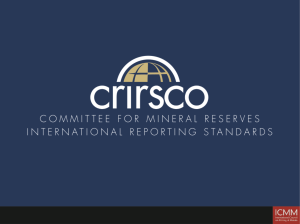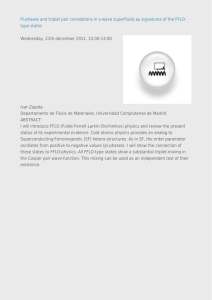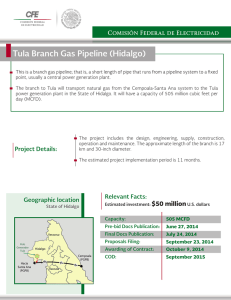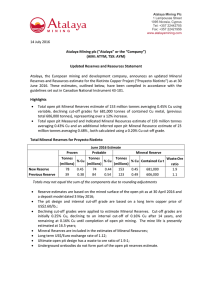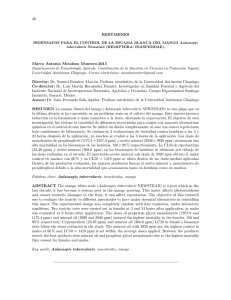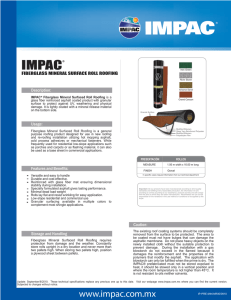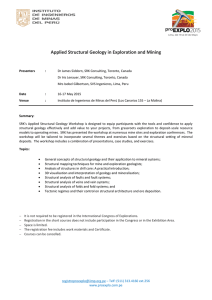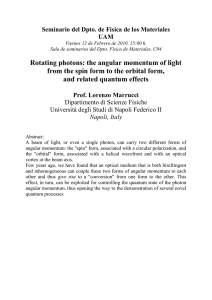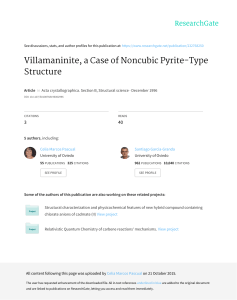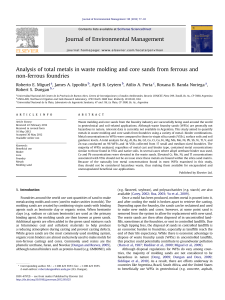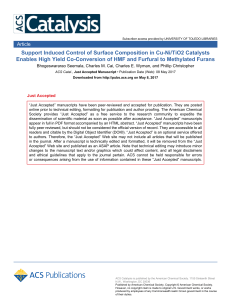chapitre_15 - Universidad Autónoma del Estado de Hidalgo
Anuncio
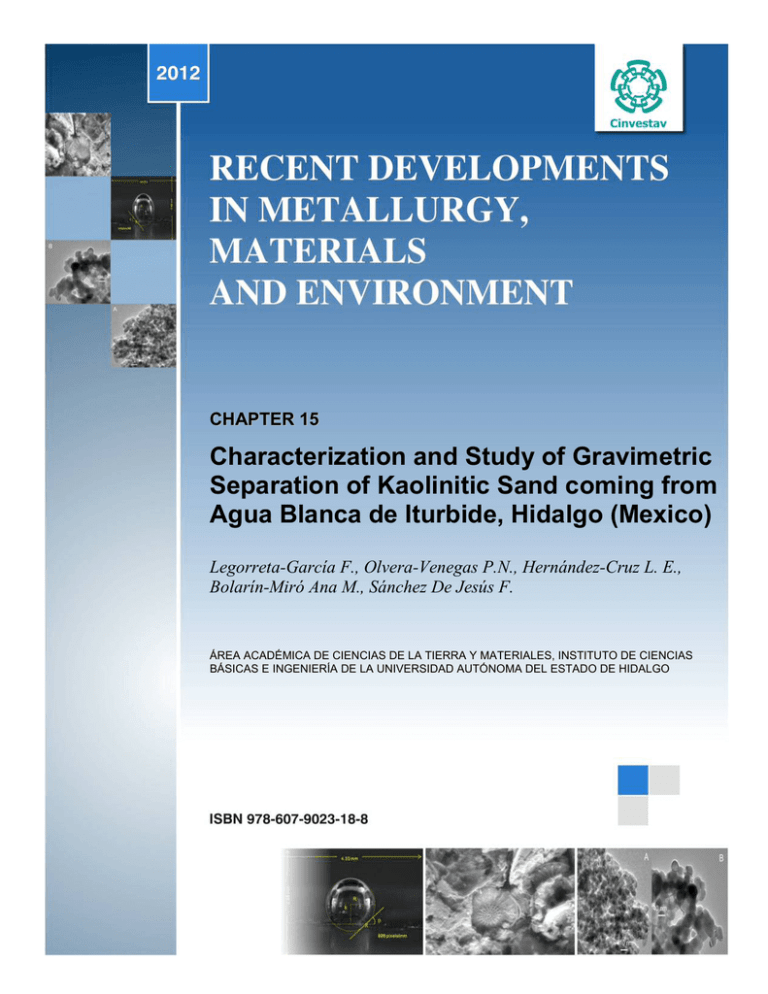
CHAPTER 15 Characterization and Study of Gravimetric Separation of Kaolinitic Sand coming from Agua Blanca de Iturbide, Hidalgo (Mexico) Legorreta-García F., Olvera-Venegas P.N., Hernández-Cruz L. E., Bolarín-Miró Ana M., Sánchez De Jesús F. ÁREA ACADÉMICA DE CIENCIAS DE LA TIERRA Y MATERIALES, INSTITUTO DE CIENCIAS BÁSICAS E INGENIERÍA DE LA UNIVERSIDAD AUTÓNOMA DEL ESTADO DE HIDALGO Recent Developments in Metallurgy, Materials and Environment Materials CHAPTER 15 Characterization and Study of Gravimetric Separation of Kaolinitic Sand coming from Agua Blanca de Iturbide, Hidalgo (Mexico) Legorreta García F., Olvera Venegas P.N., Hernández Cruz L. E., Bolarín Miró Ana M., Sánchez De Jesús F. Área Académica de Ciencias de la Tierra y Materiales, Instituto de Ciencias Básicas e Ingeniería de la Universidad Autónoma del Estado de Hidalgo, Ciudad Universitaria, Carretera Pachuca Tulancingo Km. 4.5, Mineral de la Reforma, Hidalgo, México, 42184 Abstract In the present research characterization of kaolin waste coming from municipality of Agua Blanca de Iturbide in State of Hidalgo (Mexico) was carried out, the powders analyzed included particles that oscillate between 37 and 500 micrometers. To make their characterization X Ray Diffraction, Scanning Electron Microscopy, Chemical Analysis with Inductively Coupled Plasma (ICP) and distribution of analysis of sizes per gradation test were used. Gravimetric separation was also carried out in Wilfley concentrating table studying three parameters: flow for dilution water, table inclination and blows per minute (RPM). Obtained products were chemically analyzed, obtaining Fe and Ti oxides, and aluminum silicates. Keywords: Kaolin; Si Oxide; Gravimetric Separation 1. Introduction Mexico is one of the countries with great quantity of mineral resources, and not only in case of metallic minerals, but also in the non metallic ones. Twelve states of Mexican Republic have important kaolin 156 (Al2O3.SiO2.2H2O) deposits, being Hidalgo, Zacatecas, Veracruz, and Guanajuato, states that have figured between the first places in production for this mineral in last years [1]. Within geographic zones with more importance in kaolin deposits in State of Hidalgo is Agua Blanca de Iturbide whose geologic potential extends up to state of Veracruz, for the most part in Huayacocotla, however, the economic value of their minerals is very low due to the great quantity of impurities that contains [1, 2]. In general, kaolin deposits in Mexico are very irregular, they exist in diverse qualities, very heterogeneous particle sizes and with diverse impurities such as, iron, titanium oxides, quartz and silica [3]. One of their main impurities are SiO2 sands which is a relatively stable compound; it is a by product that is created during geologic formation of kaolin (clay made up of very fine particles) which means that to be able to obtain it is absolutely necessary to carry out sizes separation whose thick particles correspond for the most part to silica and for this reason it is considered important to process it and to give it an use because these sands generate to the companies an important monetary loss in long term [4, 5]. Basically, their processing is divided in two different paths, according to its final quality: in dry and wet. The first one is mainly used in kaolins with greater silica content and the second one in kaolins with high alumina contents [6 8]. In dry processing only sand is removed, kaolin is classified by particle sizes and it is dried off. In the last one, there are also carried out other steps in which water is used for cleaning to obtain finer product and of greater quality; this last one is used mainly for paper industry [8]. In some kaolin purification plants, after mechanical preparation there is a stage that is called degritting; these sands contain high silica, alumina and other impurities percentage, which represent a problem to environment [9 12]. By this reason in this work silica sands obtained from processing of kaolin mineral coming from Agua Blanca de Iturbide, Hidalgo (Mexico), are physical and chemically characterized, determining their species and separating them by means of Wilfley concentrating table with the purpose of finding them alternative use and the viability of giving them value added instead of discard them. 2. Experimental procedures As raw material it was used samples of kaolin mineral obtained directly from mines of Agua Blanca de Iturbide, Hidalgo. Material coming from mine reduced its size by means of an Allis Mineral Systems' jaw crusher, model N184T17FB12C, until obtaining 100% of material pieces at ¼ inches. Then, broken mineral fed to a Denver flotation cell with double blade propeller, to which was added water until obtaining a homogeneous and thick pulp, without determining the percent of solids in weight. Pulp went by a series of Tyler sieves, with help of water, with the purpose of carrying out sieve analysis. Head ore constituted by particles of sand, whose sizes ranged between 500 and 37 m, was sampled and pulverized in agate mortar to then analyze it chemically with a Perkin Elmer brand spectrometer of high dispersion of plasma coupled inductively (ICP), model Optima 3000 XL. o this mineral it was made a crystallographic analysis in an Inel brand X ray diffractometer, model Equinox 2000, with a step of 0.02º in the range of 10 110º (2 ) using radiation of Cu K ( = 1.5418 Å) and to determine its morphology, was used a Jeol brand scanning electron microscope, model JSM 6300, also it was carried out semiquantitative chemical analysis by energy dispersion spectroscopy (EDS) to determine chemical composition of powders to corroborate the approximate percentage concentration of iron oxides, (Fe2O3), titanium oxides (TiO2), silica (SiO2), and alumina (Al2O3) in sands sample. 157 Such sands were separated by means of laboratory Wilfley concentrating table standard type 13 A, and during all tests pulp feeding was constant with a flow rate of sands of 15 kilograms per hour at 18% of solids in weight, studying three parameters: flow for dilution water, table inclination and blows per minute (rpm) provided by tapping mechanism and that it can be voluntarily adjusted by means of a crank (rpm). In all tests two products were obtained: heavy and light, which were filtered in dry and weighed to carry out corresponding characterization and to obtain the recovery percentages in weight. 3. Results and discussion In this section, results of the tests carried out with the samples in the above mentioned conditions are shown. 3.1 Characterization The material was processed in dry, coming from the mine, reducing it in size, quartering it and attritioning its pulp, then to make an analysis of particle sizes distribution , as well as chemical analysis for each obtained product of each mesh. The obtained results are shown in Table 1. Sieves analysis or gradation test that appears in retained percentages in each mesh, indicates that 29.6% of material are sands, material subject of this study. More than 70% in weight of sample show sizes lower than 37 m, due to origin of clayish material. Please note also that percentages in weight of ranges between 297 and 210 m, and from 149 a 125 m show the most important values (4.5%). The average calculated of particle size of sands, corresponds to 68.6 m. Size Fe2O3 TiO2 SiO2 Al2O3 0.802 0.512 31.36 58.39 0.869 0.875 0.786 0.873 0.926 0.943 1.061 0.895 0.864 0.866 0.788 0.43 0.457 0.421 0.446 0.555 0.519 0.528 0.406 0.428 0.472 0.557 27.00 24.48 27.97 28.00 29.86 24.25 26.31 28.77 36.19 30.26 35.33 58.32 58.71 55.67 57.51 53.86 58.16 61.29 60.43 53.54 57.33 57.21 Standard deviation 0.075 Table 1 Sieves analysis of mineral mine. 0.051 2.203 1.432 (µm) Heat mineral analized wt % +595 595 +500 500 +297 297 +210 210 +149 149 +125 125 +105 105 +63 63 +53 53 +44 44 +37 37 0.00 1.70 3.90 4.50 2.80 4.50 1.70 2.80 3.90 2.80 1.10 70.40 100 158 With the aim of working with a narrow range of particle sizes and whose retained percentage was important, there were worked with kaolin sands with sizes that range between 500 and 37 micrometers. Then from now on results will only be referring to work carried out with sands inside this range. Crystallography study of kaolin sands is shown in Figure 1, analysis shows mainly two mineral species, kaolinite and silica; this last one is detected as the main phase, in quartz, tridymite and cristobalite form. This fact shows that there is kaolin adhered to sands. Within other impurities detected there can be signs of iron and titanium oxides (Fe2TiO4) and greigite (Fe3S4). These results suggest proposal of carrying out some processing to sands, with the purpose of increasing the recovery in weight of kaolin clays. 6000 K= KAOLINITE (Al2O 3)2(SiO 2)2(H2 O) Q = QUARTZ (SiO 2) Q T = TRIDYMITE (SiO 2) Intensity (counts) C = CRISTOBALITE (SIO 2) TF = IRON TITANIUM OXIDE (Fe2TiO4 ) C 4000 T H K G = GREIGITE (Fe3S4) Q/K 2000 C/T T K KG G TF K K Q K K G T C G TF Q Q KG GT Q G QQ Q G K K Q/K 0 10 15 20 25 30 35 2q 40 45 50 55 60 65 Figure 1. Diffractogram of mineral species of kaolin sands whose particle sizes range between 500 and 37 m. Also to these sands there were done chemical semiquantitative analysis by energy dispersion spectroscopy (EDS) to determine their chemical composition and to corroborate the approximate percentage concentration of silica and alumina in the sample, these results are shown in Table 2 where there can be appreciated that has 30.140 % de SiO2 and 55.39 % de Al2O3. In Figure 2 an image is presented at low zooms of morphology of kaolinite sands, which show an irregular shape, a smaller proportion has lengthened form, some are surfaces with a compact consistency and other surfaces are porous. The compact surfaces could correspond to silica particles 159 and the porous particles to mixture of mineralogical species of silica and kaolin clay. The particle sizes distribution is concordant with that obtained and shown in granulometric analysis. Chemical analysis (%) Sample Fe2O3 TiO2 SiO2 Al2O3 Heat mineral analized 0.80 0.302 29.902 57.500 Sands analized by SDE (+/ 0.2%) 0.99 0.240 30.140 55.390 Table 2. Chemical semiquantitative analysis by energy dispersion spectroscopy (EDS), compared with the calculated head. Figure 2. Image of Scanning Electron Microscopy of kaolin sands. Once characterized the sample of sands, gravimetric separation was done based on formula of concentration approach that for this case was 4, and therefore it was feasible to separate, by means of concentrating table, part of impurities (Fe and Ti oxides) contained in kaolin clays. The analysis of results obtained in each one of the tests, was mostly focused in the weight recoveries obtained and in chemical analyses of light products, due to the decrease of impurities in these products, is a good indication of separation efficiency. 160 3.2 Study of effect in quantity of dilution water With the purpose of studying flow rate of diltuion water for pulp in concentrating table, three different flows at 3, 6 and 9 Lmin 1 of water were added. During whole test, there were kept constant feeding of 15 kg h 1 at 18% of solids in weight, an inclination angle of 8° and the blows per minute in 320 rpm. The chemical analyses of obtained products, that is to say of heavy and light ones, are shown in Table 3. Dilution water (L min 1) 3 6 9 Chemical analysis (%) Product wt % Heavy Fe2O3 TiO2 SiO2 Al2O3 24.6 0.853 0.412 23.90 62.20 Light 75.4 0.666 0.260 31.97 57.19 Heavy 18.8 1.019 0.449 21.19 60.05 Light 81.2 0.605 0.268 31.92 55.58 Heavy 9.6 1.131 0.549 18.45 67.31 Light 90.4 0.639 0.271 31.08 49.31 Head mineral 100 0.8 0.302 29.902 57.50 calculated Table 3. Chemical Analysis of the products of concentrating table, when studying dilution water effect. The results show a low percentage in weight of heavy products; which is due to low concentrations of Fe and Ti. Note that for light products, there is a decrease of contents of Fe2O3 and TiO2 for the three tests carried out at different water flows, however, an increment is shown for silica SiO2, but the alumina contents Al2O3 remain practically stable. In left side bar of Figure 3 percentages of analyses of sample of sands from head mineral are shown, that is to say, before being separated and it is compared with results obtained in light materials. It shows a maximum reduction of oxides of Fe and Ti to the test on a flow of 6 Lmin 1, with recovery of 81.2% for the light materials. This water flow allows an optimal force to sweep the light material, without drag the heavy particles. Therefore, it was decided to fix a flow rate of 6 Lmin 1 for the consequential experiments with adequate separation of minerals containing Fe2O3 and TiO2, obtaining an acceptable recovery. 3.3 Study of inclination angle effect During this study, there was kept constant feeding of 15 kg h 1 at 18% of solids in weight, a flow rate of dilution water of 6 Lmin 1 and blows per minute in 320 rpm. The angles of 4.5°, 8°, and 11.5° of inclination were calculated. The preliminary tests carried out with angles lower than 8°, demonstrated that there is not flow of pulp, stagnating the mineral in the rifles of table, then there were only worked with 8° and 11.5°. The results of the chemical analyses are shown in Table 4. 161 Fe 2O3 and TiO2 content in light mineral (%) The results obtained in this study show a percentage in weight of recovery of lower mineral at an angle of 11.5° because an important part of the mineral is dragged to area of light materials, taking these an important proportion of the undesirable oxides (refer to Figure 4). 0.9 0.8 0.7 0.6 0.5 Fe2O3 0.4 TiO2 0.3 0.2 0.1 0 HEAD MINERAL 3 6 9 Water flow (L.min-1) Figure 3. Comparison of the contents of Fe2O3 and TiO2 of light materials, with respect to tests carried out in Wilfley table, varying water flow. Tilt angle 11.5 ° 8° Chemical analysis (%) Product wt % Heavy 15.2 1.3 0.8 11.1 64.3 Light 84.8 0.7 0.4 21.7 57.5 Heavy 18.8 1.019 0.449 21.19 60.05 Light 81.2 0.605 0.268 31.92 55.58 100 0.8 0.302 29.902 57.50 Head mineral calculated Fe2O3 TiO2 SiO2 Al2O3 Table 4. Chemical analysis of products of Wilfley table, when was studied the inclination angle effect. While chemical analyses of light products demonstrate decrease in concentrations of Fe2O3 and TiO2, for both inclinations, results with more decrease of such concentrations are presented when using an inclination angle of 8°; the percentage difference in weight between one test and the another is only of 3.6 percentage points for which is decided to use in tests 8° of inclination for the table. 162 Fe2O3 and TiO2 content in light mineral (%) 0.9 0.8 0.7 Fe2O3 0.6 TiO2 0.5 0.4 0.3 0.2 0.1 0 HEAD CABEZA 8° 11.5° Inclination table (degrees) MINERAL Figure 4. Comparison of contents of Fe2O3 and TiO2 for light materials, with respect tests carried out in Wilfley table, varying inclination angle of the table. 3.4 Study of revolutions per minute effect During the study of this parameter, there was kept constant feeding of 15 kg h 1 at 18% of solids in weight, a flow rate of dilution water 6 Lmin 1 and an inclination angle of 8°. The results of chemical analysis of each species are shown in Table 5. Chemical analysis (%) Product wt % rpm Fe2O3 TiO2 SiO2 Al2O3 220 270 320 Heavy 21.2 0.906 0.649 14.802 59.96 Light 73.9 0.781 0.475 24.174 49.59 Heavy 16.8 0.979 0.834 11.677 57.35 Light 83.2 0.778 0.441 26.485 50.73 Heavy 18.8 1.019 0.449 21.19 60.05 Light 81.2 0.605 0.268 31.92 55.58 100 0.8 0.302 29.902 57.50 Head mineral calculated Table 5. Chemical analysis of products of concentrating table, when studying revolutions per minute effect. 163 Fe2O3 and TiO2 content in light mineral (%) When comparing the three tests it can be observed in this table that use of 270 rpm shows, in chemical analyses, highest recovery in mineral weight. However the contents of TiO2 in light products increases. When using 320 rpm, concentrations of evaluated impurities decrease and the recovery in weight is acceptable. The silica contents and alumina don't differ from those of the head. Consequently it has been considered that a good separation is obtained using 320 rpm (see Figure 5) 0.9 0.8 0.7 Fe2O3 0.6 TiO2 0.5 0.4 0.3 0.2 0.1 0 HEAD MINERAL 200 270 320 Strokes per minute (rpm) Figure 5. Comparison of contents of Fe2O3 and TiO2 of light materials, with respect to tests carried out in Wilfley table, varying rpm. 4. Conclusions In this work it was characterized and carried out study of gravimetric separation of kaolin sands coming from Agua Blanca de Iturbide, of Hidalgo State (Mexico). A physical and chemical characterization of origin samples showed mainly two mineral species, kaolinite and silica; this last one was detected as main phase, in quartz form, tridymite and cristobalite. Inside the other detected impurities signs of iron and titanium oxides (Fe2TiO4) could be observed and of griegite (Fe3S4). The study suggested that it is important to carry out a decrease in size of particles in order to release silica from aluminum silicates. The chemical analyses in obtained products put in evidence the separation of silica particles. The study of gravimetric separation in Wilfley table carried out in this work showed that operation parameters used from the beginning were the most appropriate, under conditions of feeding pulp, 15 kg h 1 and 18% of solids in weight. In all cases the use of table was appropriate for separation of Ti and Fe compounds that were found when characterizing by X ray diffraction and chemical analysis. It is important to highlight that it should be used enough water to drag the material and to make the separation function, however the use of high flows of water impedes the work of rifles of table dragging practically whole material to storage of light products, finding that optimum flow of dilution water was of 6 Lmin 1. As for the inclination of concentrating table it was evident that it is not appropriate to work with inclinations from 0 to 7° because this generates that solid material is stagnated and working from that on with inclinations of 9° causes that most of the mineral moves to 164 storage of light products, finding that optimum angle of inclination is that of 8°. Finally the most appropriate rpm was when working at 320 since better recoveries were obtained. Acknowledgements The authors wish to thank to COCyTEH through project FOMIX No. 97367 for the resources granted for the realization of this work References Referencias 1. E. García, “Inventario físico de los recursos minerales de Agua Blanca, Hidalgo”, FIFOMI, (2004) pp.4 5. 2. Dirección General de Minería (2007), Perfiles de Mercado del Caolín, Coordinación General de Promoción Minera de México, pp.7 12 3 S. E. Coordinación General de Minería.(2010), Anuario Estadístico de la Minería Mexicana Ampliada 2009. Coordinación General de Minería No. 39, ISBN 970 9897 14 4, México. 4. G. Kulbicki&G. Millot, “L’évolution de la fraction argileuse des grès petroliers cambro ordoviciens du Sahara central”, Bull. Serv. Carte Géol. Als-Lor, Vol. 13, (1969) pp.147 156. 5. K. Shah,“What is Silica?”, EBS 425 – Mineral Perindustrian, (2004) pp. 1 7. 6. S. Kahraman, M. Onal, Y.Sarõkaya, I.Bozdogan, “Characterization of silica polymorphs in kaolins by X ray diffractionbefore and after phosphoric acid digestion and thermal treatment”, AnalyticaChimicaActa, Vol. 552 (2005) 201–206 7. D.R. Nagaraj, “Non sulfide mineral flotation: An overview", Proceedings of Symp. Honoring M. C. Fuerstenau, Society of Mining, Metallurgy, and Exploration, Inc., Littleton, CO, (1999) pp. 2000. 8. G.Mercier, J.Duchesne, D. Blackburn, “Removal of metals from contaminated soils by mineral processing techniques followed by chemical leaching”, Water, Air, & Soil Pollution, Vol. 135, No. 1, (2002) pp.105–30. 9. E. Hansen, V. Williams, “Physical properties of kaolin/sand slurry used during sumersible mixer pump test at TNX”,Savannah River National Laboratory, (2004) pp.1 33. 10. F. de M. Harp, “Metalurgia de minerales ferro titaníferos”, XXVIII Convención Minera Internacional, AIMMGM AC, Veracruz, Ver., México, Octubre 28 31(2009) pp. 239 246. 11. T. Toya, Y. Kameshima, A. Nakajima, K. Okada,“Preparation and properties of glass ceramics from kaolinclay refining waste (Kira) and paper sludge ash”, Ceramics International, Vol. 32 (2006) pp. 789–796. 12. T.Toya, Y.Kameshimaa, A. Yasumori, K. Okada,“Preparation and properties of glass ceramics from wastes (Kira) of silica sand and kaolin clay refining”,Journal of the European Ceramic Society,Vol. 24 (2004) 2367–2372. 165 Desarrollos Recientes en Metalurgia, Materiales y Medio Ambiente ISBN 978-607-9023-17-1 CONTENIDO PREFACIO Capítulo 1 ii METALURGIA EXTRACTIVA Oxidación Acuosa de los Productos de la Reducción de Calcopirita Página 1 O. J. Solis-Marcial, G.T. Lapidus-Lavine 2 Lixiviación Reductiva de Lodos de Manganeso 12 M. Gutiérrez-Muñoz, V.H. Brito-Ramos, E. Pérez-Anacleto, I. Pérez-Cruz, G.T. Lapidus-Lavine 3 Lixiviación Oxidante de Minerales Tipo Sulfuros Empleando Microondas y Ozono 23 F. R. Carrillo-Pedroza, M. J. Soria-Aguilar, E. T. Pecina-Treviño, P. Aguilar-Morua 4 Efecto del MgO y Mg(OH)2 en la Tostación y Lixiviación de un Mineral Refractario de Oro y Plata 34 J. H. Coronado- López, J. L. Valenzuela-García, A. Valenzuela-Soto, M. A. Encinas-Romero 5 Molienda Ultrafina como Pretratamiento antes de Cianurar un Mineral Refractario de Oro 45 J.A. González Anaya, F. Nava-Alonso, E.T. Pecina-Treviño 6 Dependencia de la Temperatura y Estudio Termodinámico de Oro Contenido en Soluciones Base Tiosulfato 56 G. Juárez L., I. Rivera L. , F. Patiño C., E. Salinas R., J. Hernández A., M. Pérez L., E. Yescas M. y R. Martínez M 7 Extracción de Plata de Soluciones Ácidas de Tiourea con el Ácido bis(2-etilhexil) Ditiofosfórico Z. Gamiño-Arroyo, A. Buch, D. Pareau, M. Avila-Rodríguez, L.E. Sánchez-Cadena, A.R. Uribe Ramírez, M. Stambouli v 67 Desarrollos Recientes en Metalurgia, Materiales y Medio Ambiente ISBN 978-607-9023-17-1 8 Separación Selectiva de la Esfalerita, Pirita y Cuarzo en el Circuito de Flotación de Zinc 78 Gloria I. Dávila Pulido, Alejandro Uribe Salas, Fabiola C. Nava Alonso 9 Capacidad de Adsorción y Despojamiento de Zinc Presente en Solución Acuosa, Utilizando la Resina Quelante, Dowex M-4195 89 Martínez Meza, Ramona Guadalupe, Almazán Holguin, Luis Alonso 10 Eficiencia Energética del Proceso de Remoción de Zinc a partir de Escorias 100 G. González Múzquiz, J. Jiménez Ramírez, J. L. Rodríguez Galicia 11 Eficiencia Energética de Horno de Producción de Zinc a partir de Blenda Tostada 111 G. González Múzquiz, J. Jiménez Ramírez, J. L. Rodríguez Galicia MEDIO AMBIENTE 12 Aislamiento de Microorganismos de Efluentes Mineros 122 C. E. Jaramillo-Gómez, O. Monge-Amaya, M.T. Certucha-Barragán, E. Acedo-Felix, F. J. Almendariz-Tapia 13 Activación de Zeolitas en un Horno Solar para su Aplicación en la Remoción de Micotoxinas 133 G. T. Munive, A. L. Leal-Cruz, J.L. Servín-Rodríguez, J. Varela-Salazar, M. I. Pech-Canul, J. A. Rodríguez-García y E. Rocha-Rangel 14 Recuperación de Estroncio de Aguas Residuales por el Proceso Electroquímico con Electrodos de Hierro y Análisis Termodinámico Gregorio González Zamarripa, José R. Parga Torres, Víctor M. Vázquez Vázquez vi 144 Desarrollos Recientes en Metalurgia, Materiales y Medio Ambiente ISBN 978-607-9023-17-1 15 Efecto de los Parámetros del Proceso de Activación de Chabasita sobre la Remoción de Flúor 155 J.L. Servín-Rodríguez, A. L. Leal-Cruz., G. C. Tiburcio-Munive, M.I. Pech-Canul, J. A. Rodríguez-García y E. Rocha-Rangel 16 Cinéticas de Flotación para la Remoción de Cromo por Flotación Iónica 166 L. Morales Damián, M. Caudillo González, E. Elorza Rodríguez, J. L. Quiroga Velázquez 17 Aplicación de un Diseño de Experimentos Factorial 23 para el Estudio de la Cinética de Remoción de Iones Cromo con Wollastonita Natural a Partir de Soluciones Sintéticas de Cromo (VI) en Medio Ácido 177 M.A. Encinas-Romero, L. A. Núñez-Rodríguez, A. Gómez-Álvarez 18 Recuperación del Complejo Oro Tiosulfato Utilizando Guanidina en una Resina de Intercambio Aniónico 188 M. E. Chaparro-Félix, J. L. Valenzuela-García, G. Tiburcio-Munive, J. R. Parga-Torres, S. Aguayo-Salinas MATERIALES 19 Recubrimiento Biomimético de Ferritas para el Tratamiento de Cáncer por Hipertermia 199 E.M. Múzquiz-Ramos, D.A. Cortés-Hernández, J.C. Escobedo-Bocardo, M.A. Aguilar-González, J.G. Osuna-Alarcón 20 Modelación Matemática de Temperatura para la Deposición de Partículas de Fe-Cr-Mo sobre Acero D2 por HVOF C. A. Guevara Chávez, J. L. Acevedo Dávila, P. Hernández Gutiérrez, F. Cepeda Rodríguez vii 210 Desarrollos Recientes en Metalurgia, Materiales y Medio Ambiente ISBN 978-607-9023-17-1 21 Análisis Mediante el Método de Elementos Finitos del Comportamiento Térmico, Mecánico y Microestructural en la Unión de Soldadura Multi-pasos GMAW de Placas de Acero Hardox 400 y ASTM 514 221 F. Cepeda Rodríguez, J. L. Acevedo Dávila, E. D. Aguilar Cortez, C.A. Guevara Chávez, P. Hernández Gutiérrez 22 Efecto de los Parámetros de Proceso en la Formación de Al4C3 durante la Soldadura Láser de Nd:YAG en Compuestos Avanzados de Aluminio-Grafito 232 E. D. Aguilar-Cortes, F. J. García-Vázquez, J. L. Acevedo-Dávila, F. Cepeda-Rodríguez, M. I. Pech-Canul 23 Efecto de la Velocidad de Avance y Mezcla de Gases de Protección en la Penetración y Propiedades Mecánicas Durante la Fabricación de Tubería de Acero Inoxidable 304L por el Proceso GTAW 243 P. Hernández-Gutiérrez, J. L. Acevedo-Dávila, J.J. Ruíz Mondragón, C.A. Guevara Chavez1, F. Cepeda-Rodríguez 24 Determinación de la Estructura Cristalina del Sulfualuminato de Estroncio Sr4Al6O12SO4 254 J. A. Rodríguez-García, E. Rocha-Rangel, J. M. Almanza Robles, J. Torres Torres, A. L. Leal Cruz, T. Munive G 25 Preparación y Sinterización de Polvos Finos de SrTiO3 Mediante la Transformación de Mineral de Celestita Bajo Condiciones Hidrotérmicas 265 Y. M. Rangel-Hernández, J. C. Rendón-Angeles, Z. Matamoros-Veloza, M. I. Pech-Canul, K. Yanagisawa 26 Purificación de Arcillas de Caolín Mediante Técnicas Electroquímicas Flores Segura J. C., Reyes Cruz V. E., Legorreta García F., Hernández Cruz L.E., y Veloz Rodríguez M. A. viii 276 Desarrollos Recientes en Metalurgia, Materiales y Medio Ambiente ISBN 978-607-9023-17-1 27 Caracterización y Estudio de Separación Gravimétrica de Arenas de Arcillas Caoliníticas Procedentes de Agua Blanca de Iturbide, Hidalgo (México) 287 Legorreta-García F. , Olvera-Venegas P.N. , Hernández-Cruz L.E. , Bolarín-Miró Ana M. y Sánchez De Jesús F. 28 Síntesis In-Situ de Materiales Refractarios Base CaAl2O4 a Partir de Diferentes Materias Primas 298 E. Rocha-Rangel, J.A. Rodríguez-García, E. Refugio-García, J.G. MirandaHernández, J.M. Almanza-Robles y J. Torres-Torres 29 Evaluación Microestructural de Materiales de Al2O3 -ZrO2-SiO2 309 G.I. Vázquez Carbajal, J.L. Rodríguez Galicia, J.C. Rendón Ángeles, J. López Cuevas, C.A. Gutiérrez Chavarría 30 Cintas Porosas de Circón Obtenidas por el Método de Colado en Cinta 320 M. León-Carriedo, C. A. Gutiérrez-Chavarría, J. L. Rodríguez-Galicia, J. López-Cuevas 31 Soldadura Compuesta con Matriz de SnAgCu Reforzada con Partículas de CuAlAg 331 S.B. Castro Salinas, J. García Rocha 32 Influencia de la Composición de la Aleación de Aluminio sobre la Variabilidad del Ángulo de Contacto en substratos de SiC 342 M. Montoya-Davila, R. Escalera-Lozano, M. I. Pech-Canul and M. A. Pech-Canul 33 Influencia de las Fases de Reforzamiento sobre el Comportamiento de Corrosión de Compósitos Al/SiC en NaCl 0.1M R. Escalera-Lozano, M. Montoya-Dávila, M.A. Pech-Canul, M.I. Pech-Canul ix 353 Desarrollos Recientes en Metalurgia, Materiales y Medio Ambiente ISBN 978-607-9023-17-1 34 Comportamiento de la Corrosión de una Aleación Al-17%Si-14% Mg en Disoluciones de Cloruros 364 M.A. Pech-Canul, M.I. Pech-Canul, J.M. Guevara Vela, V. M. Ugalde Saldívar3, J.C. Aguilar, E.E. Coral-Escobar 35 Fabricación de Aleaciones Al-Zn-Mg Resistentes a la Corrosión usando Reciclaje de Ánodos de Baterías Alcalinas Descargadas y Latas de Aluminio 375 R. M. Ochoa Palacios, J. Torres Torres, A. Flores Valdés, J. M. Almanza Robles 36 Formación de Aluminatos de Estroncio por Reacción en Estado Sólido de Mezclas SrCO3-Al2O3 con Activado Mecánico 386 J. Torres Torres, R. Saldaña Garcés, A. Flores Valdés 37 Propiedades Mecánicas de Materiales Compósitos del Sistema Binario Ba0.75Sr0.25AlSi2O8-ZrO2, Sintetizados por Reacción en el estado Sólido a Partir de Materias Primas Activadas Mecánicamente 397 M.V. Ramos-Ramírez, J. López-Cuevas, J.L. Rodríguez-Galicia 408 38 Síntesis por Reacción en el Estado Sólido de Celsiana de Estroncio a Partir de Mezclas de SrCO3, Al2O3 y Ceniza Volante Activadas Mecánicamente C.M. López-Badillo, J. López-Cuevas, S. Díaz de la Torre 39 Reemplazo Parcial del CaO por BaO en Muestras Vitrocerámicas del Sistema SiO2-Al2O3-CaF2-RO (R = Ca, Mg, Ba) M. Garza-García, J. López-Cuevas, C.A. Gutiérrez-Chavarría, N. Piedad-Sánchez, E. Camporredondo-Saucedo x 419
